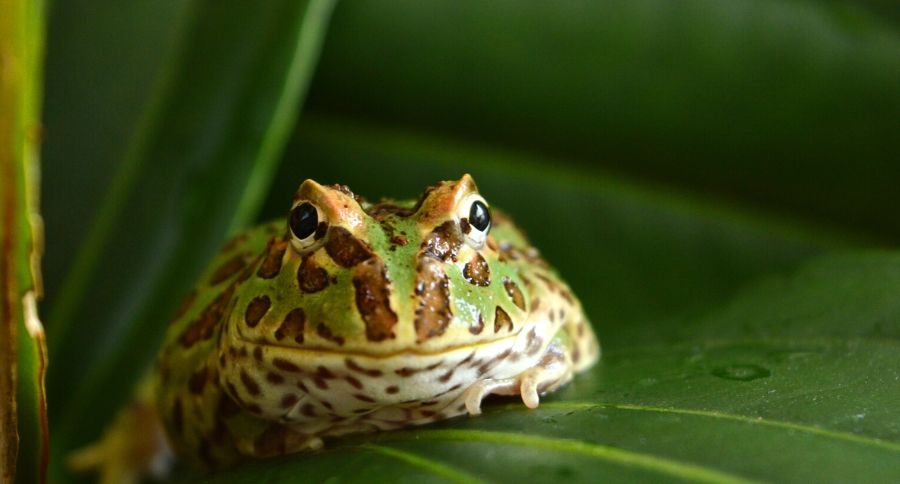You can easily see where they get their name from! Look at these pics. Their rounded appearance and huge mouths are adorable and they look just like the frogs from PacMan.
After researching this care guide and finding out how easy these frogs are to take care of I'm tempted to run out and bring one home! A frog expert with Reptiles Magazine explains these frogs are easy to care for and have a forgiving nature.
Behavior and handling
Yikes! We also learned from Reptiles Magazine that Pacman frogs have teeth, and large Pac-Man frogs can and will draw blood if you stick your hand in front of them! So be careful when handling your pet frog as their skin is super sensitive.
What about their behavior? In addition to being easy-going, live Pacman frogs can be mistaken for dead Pacman frogs.
"If their food is scarce this frog will "encase itself in a tough outer skin to protect it from drying out. They won't move and they look like they are dead. Once rehydrated, however, they will shed this outer skin (and eat it!)."
Housing your Pacman frog (and feeding!)
These pet frogs are about 6 inches long, with females being larger than males. They are also about as wide as they are long. They live between 7 and 10-years-old.
Their diet includes insects like crickets, mealworms, and wax worms.
(This may be the most important section).
Frog expert Josh's Frogs tells us that Pacman frogs are sit-and-wait predators.
"They spend the majority of their time burrowed into the substrate with their eyes (and horns in some species) above the substrate. Because of this, caging does not need to be spacious. Adults can be caged in enclosures of 10 to 20 gallons."
They also love to burrow. Therefore they require a substrate that they can dig in to like Coir (ground coconut). This substrate should remain damp, but not soaking wet. Many people recommend keeping a water bowl in with the Pac-Man frog.
Common health problems
https://www.instagram.com/p/B5KohmphQvm/
The Spruce Pets confirms the following health concerns need to be on your radar:
- Bacterial and fungal infections of the skin and eyes. Any redness, swelling or pus is a sign of an infection.
- A Pacman frog kept in an enclosure without enough humidity may develop a respiratory infection. This is marked by wheezing, drooling and lethargy.
- Pacman frogs also are susceptible to parasitic infections.
Choosing a Pacman frog
You should look for an active animal and their skin shouldn't have any blemishes. We recommend this a lot with frogs but a reputable breeder is the best path to a healthy pet frog.
Other nicknames are horned frog, Ceratophrys ornata, Ornate horned frog, Pacman frog, Pac-man frog, Pac man frog, South American horned frog, Argentine horned frog, ornate Pacman frog, and Argentine wide-mouthed frog.
Pacman frogs are native to South America and they are very poor swimmers. They spend most of their time in a humid environment among damp leaf litter we mentioned under housing.
Note that the resource Josh's Frogs is a great place to go to learn about this pet frog and Pacman frog care while easy needs to be researched ahead of time! Some frog experts don't include a water dish all the time in their housing but we think better safe than sorry. The keep the substrate (coconut fiber) damp.
Basically you need to know the basics from the care sheet and what needs to be included in your terrarium. A varied diet is always a good idea and the temperature in the tank should be kept around 82 degrees during the day and allowed to drop to around 78 degrees at night.
The insects should be gut-loaded prior to feeding so talk with the pet store staff about dietary needs when you bring your pet from home from your breeder. Live food is best!
Do you live with a frog? What essentials did we miss? Please leave us a comment below!
WATCH NOW: Bearded Dragons Are Awesome Reptiles!




